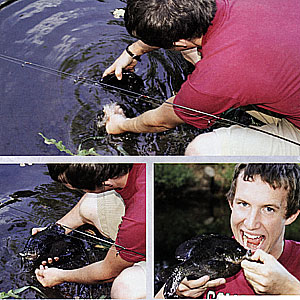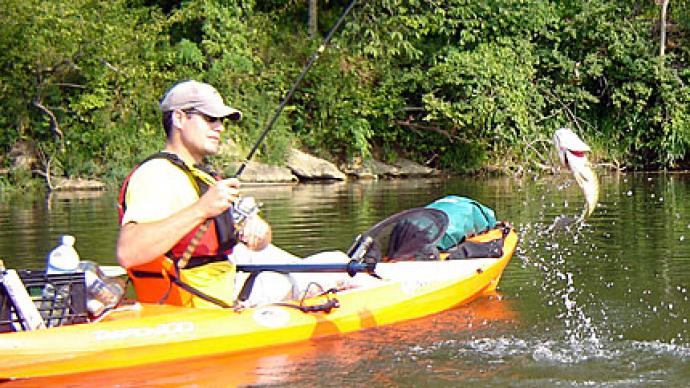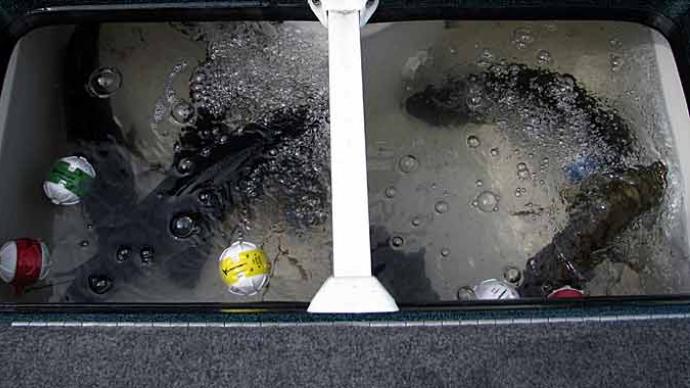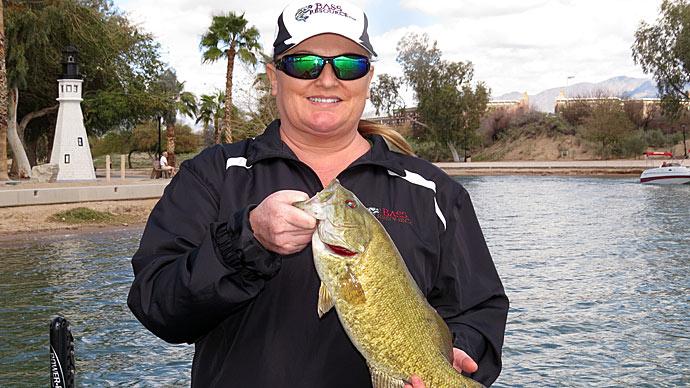
We get some interesting phone calls here at world headquarters of Pond Boss. In early September, I returned a call from a faithful Midwestern Pond Boss subscriber. When he answered the phone, I could hear the tension followed by a little sigh of relief. "Thanks so much for calling me back so quickly."
Then, he told me his story.
Built his dream pond in central Missouri five years ago. Stocked it by the book, nurtured his fish, even hand-fed them from his dock every day he could. His bluegill would be there every warm day, awaiting his kindness and the free food. Occasionally, a bass would take a swipe at the bluegill. His bass grew. He was proud.
Finally, after two years, he was ready to catch and enjoy his fish.
It was going well.
Until today.
He caught one of the biggest bass in the entire pond, a voluptuous female with a lovely shape. The five year old was pushing near eight pounds.
He had no idea there might be a fish so large.
He was pitching a soft plastic, a lizard, Texas rigged. She swallowed it ... whole.
He did everything he could to get the hook out without damaging the fish. He didn't have any pliers on the dock, so he held the monster by her bottom jaw and did his best to pry the hook out. Couldn't get it. He was in a quandary, trying to decide what to do. Should he bite the line and leave the hook in the fish and release her? Should he leave the fish on the line, in the water and go get some pliers?
What would you do?
Here are some tips for the proper care and handling of your fish.
When you catch a fish, do everything you can to remove the hook without damaging tissue. Personally, before you ever cast a line, I suggest you bend the barb flush to the shank to minimize tissue damage. If you deep hook a fish, keep sturdy pliers at hand to cut the hook. If you can cut the hook, it will be much easier to remove from the fish. You can get another hook, but a big fish is too hard to replace.
If you can't get the hook out, cut the hook, cut the line and gently push the hook downward into the gullet. If the hook is stuck in a gill arch, exercise extreme caution. Those red gill filaments are highly vascular and bleed easily. Once a fish bleeds, its odds of survival drop significantly.
One tidbit of information that might be helpful... unlike humans, fish blood coagulates much more quickly when the fish is in water.
What if you choose to catch and keep some fish alive ... maybe in a livewell or a dockside cage? What can you do to assist your fish?
According to Tony Gergeley, of Sure-Life Labs, a company dedicated to providing state of the art products for fish handling, there are two key components. "The two most important points to remember are water temperature and dissolved oxygen."
Cooler water holds more oxygen than warm water. Gergeley offers, "Handle fish in clean water. Fish are designed to be wet."
When you catch a fish, make sure your hands are wet. Each fish has a mucous coating on the outside, called its "slime coat." That coat is its first line of defense against disease. Dry hands dislodge and remove the slime, a definite "no-no." Keep your hands wet.
Here's another standard rule of thumb ... in a livewell, lower the water temperature by no more than 10 degrees from the water they come from. Professional anglers, in hot weather, put ice into their livewells to cool the fish and slow them down. Be careful with that with your pond fish. Actually, dramatic water temperature changes can do as much damage to a fish as any mishandling. Never change the water temperature more than 10 degrees, if you plan to keep fish alive. Here's another hint... going from warm to cool is easier and safer than going from cool to warm. Don't do it during the hottest part of a summer day.
Here's another nugget... Don't keep a fish out of water longer than 30 seconds. Remember the "30 second" rule. When a fish is held out of water for too long, its slime coat begins to desiccate. When a fish has to regenerate its slime coat, its immune system is taxed.
Gene Gilliland, long time fisheries biologist from Norman, Oklahoma, helped write the B.A.S.S. book on handling fish. In "Keeping Bass Alive," Gilliland makes a strong point about how to hold a fish.
"Hold a bass vertically by the lower jaw. Never try to hold a fish horizontally by its lower jaw.
Be prepared. If your pond or lake is home to big fish, have a good dipnet available. I suggest the rubber ones. Knotted nylon nets are abrasive to all species of fish. Avoid abrasive nets. Have pliers, always.
If you catch a fish larger than five pounds, use the dipnet. If no net is available, guide the fish to the boat or dock, kneel down and lip it with wet hands and use your off hand to cradle the lunker under its belly.
Never hold a large bass by its lower jaw only. Jaws of large fish can easily be dislocated if its mouth is opened too wide or there's too much weight on the jaw.
Here's another hint. Make sure you have no lotion or sunscreen on your hands. That stuff will compromise the fish's slime coat. The slime coat is a media and can transfer chemicals into the fish. That goes for bug repellent, too.
When a fish is caught, it is stressed. Its metabolism rises, the muscles work hard, and lactic acid begins to build along with cortisol. The "fight or flight" syndrome pushes the release of stress hormones. Muscle tissue breaks down and the immune system begins to become unstable. The fish needs to recover, once it is landed. If you put it in a livewell, there are all kinds of products and chemicals and additives you can use.
But, simply speaking, the basic rules are simple. Clean, fresh, oxygenated water with electrolytes ... salt. Uniodized salt is preferred at the rate of 0.5% Salt does two things. First, it naturally dehydrates the slime of the fish and keeps the fish from sloughing it off. Secondly, salt gives the fish an opportunity to replace electrolytes in its blood, similar to a shot of Gatorade for a runner.
Be sure the livewell is highly oxygenated and refreshed with clean water.
Many of us choose to remove and transport fish. If that's part of your mission, fill your transport tank with pond water and use the proper additives. And, be sure you have sufficient means to oxygenate your transport water. There's no sense in working to properly handle your fish, only to let them suffocate because of inadequate aeration.
When transporting fish any distance, amend the water with the "right" kind of products. Three pounds of salt in 100 gallons of water is the standard rule of thumb for fish transport experts. But, many, including one of the best in the nation, Mr. Fish, Roger Coffmann, goes a step further, "For game fish and forage fish in the private sector, I use my own concoction of salts, medications and water enhancers that help minimize stress from ammonia, one of the byproducts of fish metabolism."
For most consumers, Sure-Life is one of several companies which sell over the counter products to amend water. Educate yourself before you use any products.
Gergeley described one of their top sellers. "Catch and Release has an EPA registered and FDA approved antiseptic and disinfectant used in the food processing industry and is completely safe for use with fish. It has electrolytes, an ammonia remover, chlorine and chloramines remover and stimulates the fish to produce new slime. It also chelates and removes heavy metals and gently sedates the fish to slow its metabolism. It also has a foam retardant."
Foam retardant?
Yep, when fish are confined inside a transport tank, they tend to slough some of their slime anyway. That slime is made of amino acids, the building blocks of protein. In the presence of oxygen, the slime turns to foam and floats on top of the water, inhibiting the water's ability to hold oxygen. The foam retardant diminishes the bubbles.
What about our friend in Missouri?
His big fish made it through the first phase of handling, but not without more than one scare. And, I won't be surprised to hear from him in a week or so, if the big creature floats to the top from delayed mortality.
He held the fish wrong, kept it out of the water too long, touched it with dry hands, had no pliers, tugged and pulled at the hook until he forced it out and then took the fish to the garage to take photos before releasing it. Thank goodness he dipped the dizzy creature in the water twice during its ordeal.
Fish Handling Videos:
How To Hold a Bass The Right Way: https://youtu.be/Y1bWa0i0xAI
How To Revive A Fish: https://youtu.be/Z0icgOXZMDM
Reprinted with permission from Pond Boss Magazine



